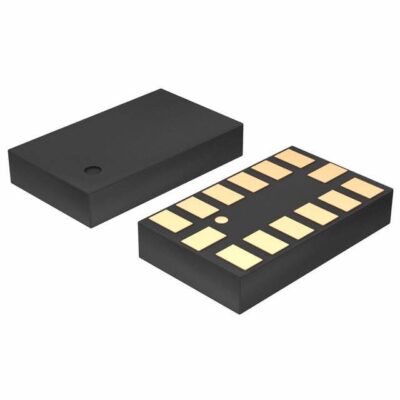ADXL345BCCZ
Part Number: ADXL345BCCZ
Manufacturer: Analog Devices Inc.
Description: ACCEL 2-16G I2C/SPI 14LGA
Shipped from: Shenzhen/HK Warehouse
Stock Available: Check with us
ICRFQ.com - Electronic Components Distributor in China Since 2003

Part Number: ADXL345BCCZ
Manufacturer: Analog Devices Inc.
Description: ACCEL 2-16G I2C/SPI 14LGA
Shipped from: Shenzhen/HK Warehouse
Stock Available: Check with us
The ADXL345BCCZ is an amazing piece of technology that is used in mobile devices, tilt-sensing and motion-detection systems, and other places. In this detailed guide, we’ll learn all about the ADXL345BCCZ 3-axis accelerometer, including its features, powers, and possible applications.
The ADXL345BCCZ is a modern 3-axis accelerometer that is known for its small size, ultra-low power usage, and high-resolution measurement capabilities. This accelerometer is made with care and made to be flexible, so it can be used in a wide range of places, from mobile devices to industrial systems.
The ADXL345BCCZ can measure both steady acceleration and acceleration that changes over time. It can measure very small changes in orientation and acceleration because it has a high resolution and an accuracy of 13 bits. This function is very helpful when even the smallest movement needs to be caught correctly.
The ADXL345BCCZ has several advanced sensing features on top of what it does best. Some of these are detecting movement and inactivity, taps, and free-fall. These features make it better at recognizing and responding to different types of motion and acceleration events. This makes it a strong tool for recognizing gestures, detecting impacts, and more.
The ADXL345BCCZ is a 3-axis accelerometer that can measure acceleration along the X, Y, and Z directions at the same time. This ability to measure everything gives a full picture of an object’s movement and position.
The accelerometer can measure up to 16 g, where “g” stands for the motion caused by gravity. Because it has such a wide range, it can be used for everything from feeling a slight tilt to detecting a hard shock.
The ADXL345BCCZ has a high precision of 13 bits, so it can detect even small changes in acceleration. This gives a resolution of about 3.9 millimeters per least significant bit (mg/LSB), which makes it possible to track motion and direction with great accuracy.
The sensor can send digital data in a 16-bit two’s complement format. This data can be accessed using either a 3- or 4-wire Serial Peripheral link (SPI) or an Inter-Integrated Circuit (I2C) digital link. Having a choice of platforms makes it easier to integrate into different systems.
The ADXL345BCCZ has special sensing functions that allow it to do more than just measure motion. Some of these jobs are:
The sensor has two interrupt output pins that can each be mapped to a different special detecting function. This makes event-based triggers work well and cuts down on the need to ask all the time.
The ADXL345BCCZ has a 32-level first in, first out (FIFO) buffer that can keep data to reduce the amount of work the host processor has to do. This not only makes it easier to handle data, but it also helps the system use less power generally.
The sensor has low power modes that make intelligent power control based on motion possible. This lets power be saved while threshold-based sensors and active acceleration measurements are possible.
The ADXL345BCCZ is a great choice for many purposes, from consumer electronics to industrial automation, because it is precise, flexible, and uses little power.
To begin using the ADXL345BCCZ 3-axis accelerometer, follow these hardware setup steps:
Choose your preferred communication interface:
Interpret and convert sensor data:
By following these steps, you’ll access and interpret accelerometer data accurately. This forms the foundation for further programming and implementation.
The ADXL345BCCZ 3-axis accelerometer finds versatile use in various real-world applications:
The ADXL345BCCZ’s precision and advanced features make it a preferred choice across industries, revolutionizing how we interact with technology and surroundings.
Efficient power management is essential for prolonging battery life and ensuring optimal performance of the ADXL345BCCZ 3-axis accelerometer. Here are key strategies to optimize power consumption:
The ADXL345BCCZ offers low-power modes that significantly reduce energy consumption when high-precision measurements are not required. Take advantage of these modes:
Employ intelligent power management techniques to balance performance and energy efficiency:
By integrating these power-saving measures, you can extend the operational lifespan of battery-powered devices and minimize the environmental impact of energy consumption.
Whether you’re a fan of electronics, a committed hobbyist, or a professional developer with years of experience, this article has been carefully written to give you a full understanding of the ADXL345BCCZ 3-axis accelerometer. You will learn everything you need to know to use this sensor to its fullest potential in a variety of projects and uses, from its basic principles to its most complicated features. Elevate your experience with the ADXL345BCCZ by partnering with ICRFQ – your electronic components distributor in China. Access outstanding possibilities and collaborate on a limitless technological future with the ADXL345BCCZ. Today, innovate and reinvent what’s possible!
WhatsApp us